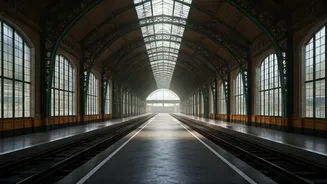Heritage Hotel's Origin
The Fullerton Hotel in Singapore, originally known as the Fullerton Building, started as a postal and railway office back in 1928. It's now a five-star
heritage hotel. It boasts intact neoclassical architecture and offers stunning views of Marina Bay. The building's transformation is a great example of how historical structures can be adapted for modern luxury. It's a blend of historical charm and contemporary comfort. The hotel showcases Singapore's commitment to preserving its past while embracing the future. It is a testament to the enduring appeal of quality craftsmanship and attention to detail. This architectural landmark continues to provide a unique and enriching experience for all visitors.
London's Gothic Grandeur
St. Pancras Renaissance Hotel in London, UK, stands as a stunning example of Gothic Revival architecture. Once the Midland Grand railway terminus, built in 1873, the hotel features impressive vaulted ceilings and dramatic staircases. It's linked directly to St. Pancras Station. The hotel's design preserves the historic essence. It also provides modern conveniences to guests. The renovation ensures the preservation of the building's historical integrity while providing a luxurious experience. This approach showcases how historical buildings can be seamlessly integrated into a modern hotel setup. It's a destination where the grandeur of the past meets the comfort of the present.
Mumbai's Colonial Legacy
Taj Wellington Mews, formerly the Chhatrapati Shivaji Maharaj Terminus Annex, is a beautifully restored colonial-era railway building in Mumbai. Connected to the UNESCO-listed CSMT station, it has become a boutique luxury accommodation. The building has been transformed while maintaining its Indo-Saracenic architecture. This transformation offers a unique stay experience. It also provides a deep connection to Mumbai's rich history. Preserving historical buildings like this showcases the city's commitment to conserving its heritage. It creates a space where history and luxury meet. It allows guests to immerse themselves in a unique cultural setting.
Mexico's Rail Heritage
Museo Hotel in Mexico is a beautiful example of a 19th-century railway station. It has been reimagined as a boutique luxury stay. The hotel has preserved its stone corridors, historic platforms, and cultural exhibits. It offers a unique glimpse into the past. It also celebrates the area's rail heritage. The transformation shows the beauty of reusing historical buildings. It creates a special experience for guests who enjoy history and culture. The hotel combines the charm of the past with modern comforts. It allows visitors to explore the rich history of the area in a luxurious setting.
Kentucky's Artistic Charm
The 21C Museum Hotel in Louisville, Kentucky, is located in what was once a 19th-century train depot. The building has been restored into a contemporary art-themed luxury hotel. It blends industrial charm with modern design. The hotel provides a distinctive experience with its focus on art. It combines historical elements with contemporary aesthetics. The transformation reflects the revitalization of urban spaces. It provides a unique setting for art enthusiasts and travelers alike. It allows guests to immerse themselves in art and history.
Stylish Edwardian Suites
The Adina Apartment Hotel has been built inside the restored Central Railway Station Parcel Post Building, dating back to 1912. The hotel combines Edwardian Baroque architecture with stylish luxury suites. The transformation of this building into a hotel showcases the fusion of historical styles. It provides contemporary amenities. The design offers guests a unique blend of heritage and modern luxury. This restoration highlights how historical infrastructure can be transformed into a stylish, functional space. The hotel provides a special setting for guests to enjoy the history and elegance of the era.
















